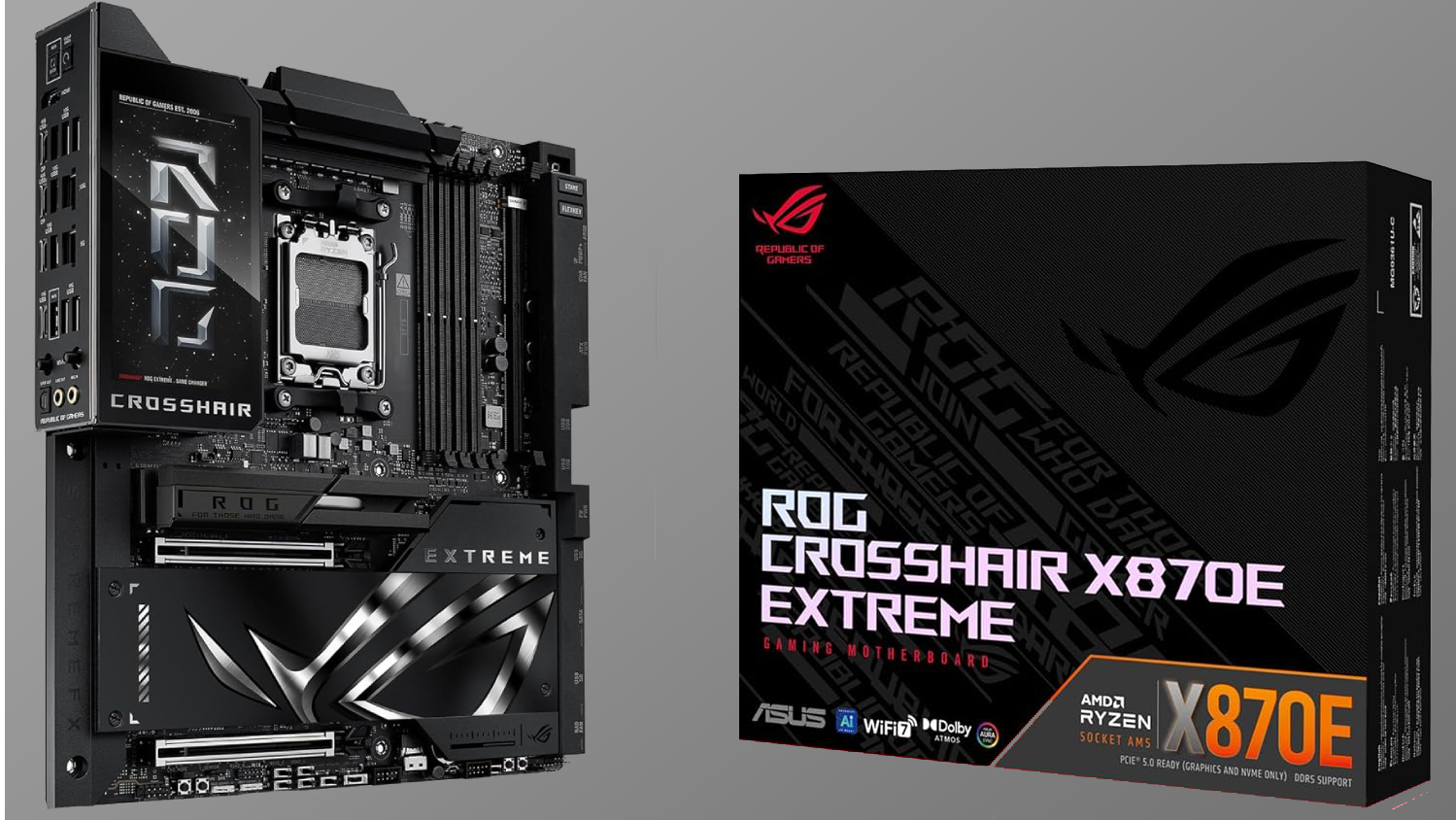Leaked Asus ROG Crosshair X870E Extreme images suggest an imminent launch
The absolute best in Asus' high-end range for AMD Ryzen AM5 processors.

An Asus ROG Crosshair Extreme X870E motherboard is in the works, according to leaked photos shared by renowned leaker momomo_us. Though detailed specifications remain in the dark, we can spot several technical and cosmetic changes over the previous X670E class model. As a descendant of Asus' premier ROG Extreme family, you can expect a hefty price tag in the ballpark of $1,000 or higher.
Asus' overclocking-tailored X870E Apex motherboards, promising a minimum overclocking window of 8,200 MT/s memory speeds for Ryzen 9000 CPUs, are expected to hit shelves next month, on April 4. For a quick recap, Asus' ROG motherboards sub-brand is further segmented into the Crosshair and Maximus families. Under these two camps, we find even more designations like Extreme, Apex, Hero, Formula, and Gene. Across all chipsets, Asus reserves the Extreme designation for its highest-end and most premium offerings.
Extreme pic.twitter.com/8sIJeS7HldMarch 29, 2025
The X870E ROG Crosshair Extreme we're looking at today carries the E-ATX form-factor, covered in black and silver accents. There's a visible departure from the colorful anime-themed design of the previous model, though the premium finish more than deems the motherboard Extreme-worthy. Atop the I/O shroud sits what we believe is a customizable LCD, and the motherboard appears to use dual 8-pin EPS power connectors. Featuring four DIMM slots, the motherboard also includes a DIMM.2 slot for an M.2 expansion card.
Ensuring optimal cooling, the first M.2 slot beneath the CPU socket is covered by a heatsink that includes a heat pipe for heat dissipation. In terms of expansion, we can spot two PCIe x16 slots, likely to support Asus' updated Q-Release Slim GPU removal mechanism. Additional M.2 slots and the two Promontory 21 chipsets are housed within a large heatsink, adorned with Asus' ROG design.
On the right, you can find Asus' Q-Code LED for POST diagnostics alongside a "START" button and a "FLEXKEY" button. The FlexKey button is used as a system reset button by default, but its functionality can be customized for other use cases. There are also several right-angled ports to the right, including one for the large 24-pin ATX connector.
The back of the motherboard is covered in a protective and stylish backplate. Rear I/O options aren't as visible as we would've wanted, though we can certainly make out a handful of USB ports, a BIOS flashback port, an HDMI port, a 5GbE, a 10GbE, and Wi-Fi 7 antenna connections, among several others. Pricing and availability are unknown at the time of writing, but Asus might announce details shortly.
Get Tom's Hardware's best news and in-depth reviews, straight to your inbox.

Hassam Nasir is a die-hard hardware enthusiast with years of experience as a tech editor and writer, focusing on detailed CPU comparisons and general hardware news. When he’s not working, you’ll find him bending tubes for his ever-evolving custom water-loop gaming rig or benchmarking the latest CPUs and GPUs just for fun.
-
das_stig Sorry Asus, no motherboard is worth $1K regardless of what components used, pure rip off of the consumer, especially from a brand that was, in many peoples eyes, no.1 top tier.Reply -
jonaswox Reply
Well someone has to pay for the development and these boards are not exactly flying over the counter. So that's a problem of this segment always. I appreciate the vast amount of features on these boards but I also regularly spend entire nights on tinkering.das_stig said:Sorry Asus, no motherboard is worth $1K regardless of what components used, pure rip off of the consumer, especially from a brand that was, in many peoples eyes, no.1 top tier.
I think it is as much a problem of modern hardware being expensive, say proper thunderbolt controllers or modern ddr implementation for example, are not cheap. No doubt Asus is not above putting a lot of icing on the cake in recent years but to offer a massively overbuild board is not in itself a bad thing. The prices have gotten kinda stupid, but the intel boards z890 are kinda expensive by design, but if this am5 comes at well above 1000$, it's just stupid. A strix board is more than enough for 99,9% -
spoidz Is there going to be any way to tell if the newer released boards (even non-Apex/Extreme) have taken care of the possible 9800X3D/9950X3D boot/over-volting issues.Reply
Yes these specific boards are for doing that very thing but for the baseline start I don't want to lose a CPU as soon as it boots. -
TechieTwo I understand overclocking and I did it for years when it produced a tangible system performance increase but to spend $1000 on a mobo and several grand on a GPU doesn't make a lot of sense to ME unless this is a necessity for work. I guess Asus would not be producing these ultra expensive toys if there was not a market for them so there must be "enough" consumers with deep pockets that are willing to spend the money for the entertainment factor because the performance gain certainly doesn't justify the cost.Reply -
Ogotai as always.. too bad there probably arent enough pci e lanes to use all the features this board has.. so some things wil get disabled if something else is used..Reply -
JayGau This board is not for regular gamers. It's either for the ultra enthusiasts with a lot of money who like to push their hardware to the limit to see their username at the top of online benchmark charts or the pros who really need the extra features. Saying this board cost too much is like saying the RTX A6000 is overpriced because you can get a 5090 for half the price.Reply -
Energy96 Too many people look at stuff like this and offer comments from the perspective of a 20 year old gamer with an entry level job. There are loads of really good boards in the $300-$500 range for the average younger gamer that offer very similar performance. These boards are meant for older gamers with well developed careers and strong incomes. Gamers that want to build something really cool and aren’t really worried about spending an extra grand on the build. It’s for people that want performance as well as something cool to look at.Reply
I’m an older gamer that has been building PC’s since the 90’s. I spend more going to the dunes for a weekend than the difference in price between the average boards and something like this. It’s all perspective. Personally in this range the MSI Godlike is a way nicer board and offers a much cleaner and over the top look. -
Firestone A $1000 motherboard that only has two PCIe slots lmao what a joke. My AM4 Dark Hero cost half as much as has twice as many slots. And yes I've got them all filled.Reply -
Firestone Reply
I have spent a minimum of $4000 USD on each of my builds over the years and still would not touch this because it doesn't have enough expansion. I recently spent weeks trying to scrounge up a single MSRP ProArt B650 ($230) in the USA because it's the only AM5 board with a sensible PCIe layout. Even more of a slap in the face when Asus seemingly halts production of such boards in lieu of "fancier" high end boards with even more expansion limitations. I don't really care how much the motherboard costs, I'm looking to plug in about $3000+ of extra expansion and accelerator devices. "Move to Threadripper/ Epyc " isn't an option either since the mobo options there are even worse and I don't need those massive TDPs or EATX cases. It's not even a question of "enough PCIe lanes" it's literally just a problem with PCIe slot configurations. This board and the others like it have gone off the deep end with useless PCIe 5.0 M.2 that literally no only needs or wants and have done it by sacrificing general expandability that's been the norm for high end desktop computing for decades. Who cares if your M.2 SSD runs at 5000MB/s instead of 15000MB/s, you can just wait a few more milliseconds for data to transfer. But there's no solution for the reduced PCIe expansion slots.Energy96 said:Too many people look at stuff like this and offer comments from the perspective of a 20 year old gamer with an entry level job. There are loads of really good boards in the $300-$500 range for the average younger gamer that offer very similar performance. These boards are meant for older gamers with well developed careers and strong incomes. Gamers that want to build something really cool and aren’t really worried about spending an extra grand on the build. It’s for people that want performance as well as something cool to look at.
I’m an older gamer that has been building PC’s since the 90’s. I spend more going to the dunes for a weekend than the difference in price between the average boards and something like this. It’s all perspective. Personally in this range the MSI Godlike is a way nicer board and offers a much cleaner and over the top look. -
Energy96 You are a rare use case for these kinds of boards and it wouldn’t make sense for you. They are targeted at gamers and no one is running more than 1 video card these days for gaming so no real need for more PCI slots. I will say the M2 PCI expansion card that comes with the MSI Godlike board, while cool, is unlikely to be used by many people. Not worth the loss of x16 on the primary slot and plenty of slots already on board. At least with this MSI board you can fully populate all the on board M2 slots without losing 16x on the main PCI slot. For me the primary PCI slot sharing with the secondary (that I have no plans to use) is the best set-up.Reply
The MSI Godlike is also by a mile the best looking board to put in a glass case. Nothing else is as clean and cool looking as this thing.